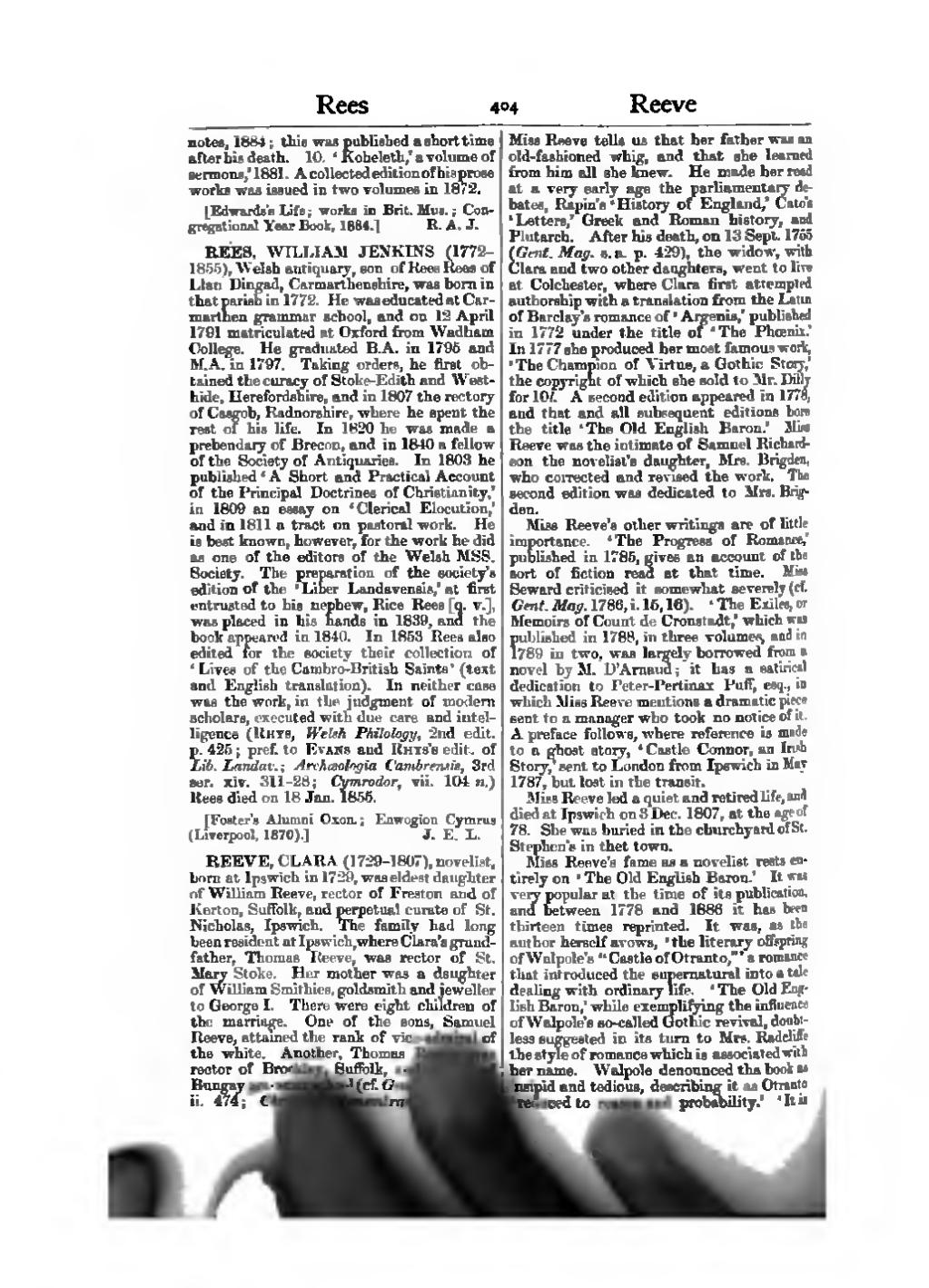notes, 1884; this was published a short time after his death. 10. ‘Koheleth,’ a volume of sermons, 1881. A collected edition of his prose works was issued in two volumes in 1872.
[Edwards's Life; works in Brit. Mus.; Congregational Year Book, 1884.]
REES, WILLIAM JENKINS (1772–1855), Welsh antiquary, son of Rees Rees of Llan Dingad, Carmarthenshire, was born in that parish in 1772. He was educated at Carmarthen grammar school, and on 12 April 1791 matriculated at Oxford from Wadham College. He graduated B.A. in 1795 and M.A. in 1797. Taking orders, he first obtained the curacy of Stoke-Edith and Westhide, Herefordshire, and in 1807 the rectory of Casgob, Radnorshire, where he spent the rest of his life. In 1820 he was made a prebendary of Brecon, and in 1840 a fellow of the Society of Antiquaries. In 1803 he published ‘A Short and Practical Account of the Principal Doctrines of Christianity,’ in 1809 an essay on ‘Clerical Elocution,’ and in 1811 a tract on pastoral work. He is best known, however, for the work he did as one of the editors of the Welsh MSS. Society. The preparation of the society's edition of the ‘Liber Landavensis,’ at first entrusted to his nephew, Rice Rees [q. v.], was placed in his hands in 1839, and the book appeared in 1840. In 1853 Rees also edited for the society their collection of ‘Lives of the Cambro-British Saints’ (text and English translation). In neither case was the work, in the judgment of modern scholars, executed with due care and intelligence (Rhys, Welsh Philology, 2nd edit. p. 425; pref. to Evans and Rhys's edit. of Lib. Landav.; Archæologia Cambrensis, 3rd ser. xiv. 311–28; Cymrodor, vii. 104 n.) Rees died on 18 Jan. 1855.
[Foster's Alumni Oxon.; Enwogion Cymrus (Liverpool, 1870).]
REEVE, CLARA (1729–1807), novelist, born at Ipswich in 1729, was eldest daughter of William Reeve, rector of Freston and of Kerton, Suffolk, and perpetual curate of St. Nicholas, Ipswich. The family had long been resident at Ipswich, where Clara's grandfather, Thomas Reeve, was rector of St. Mary Stoke. Her mother was a daughter of William Smithies, goldsmith and jeweller to George I. There were eight children of the marriage. One of the sons, Samuel Reeve, attained the rank of vice-admiral of the white. Another, Thomas Reeve, was rector of Brockley, Suffolk, and master of Bungay grammar school (cf. Gent. Mag. 1830, ii. 474; Christian Remembrancer, i. 19). Miss Reeve tells us that her father was an old-fashioned whig, and that she learned from him all she knew. He made her read at a very early age the parliamentary debates, Rapin's ‘History of England,’ Cato's ‘Letters,’ Greek and Roman history, and Plutarch. After his death, on 13 Sept. 1755 (Gent. Mag. s.a. p. 429), the widow, with Clara and two other daughters, went to live at Colchester, where Clara first attempted authorship with a translation from the Latin of Barclay's romance of ‘Argenis,’ published in 1772 under the title of ‘The Phœnix.’ In 1777 she produced her most famous work, ‘The Champion of Virtue, a Gothic Story,’ the copyright of which she sold to Mr. Dilly for 10l. A second edition appeared in 1778, and that and all subsequent editions bore the title ‘The Old English Baron.’ Miss Reeve was the intimate of Samuel Richardson the novelist's daughter, Mrs. Brigden, who corrected and revised the work. The second edition was dedicated to Mrs. Brigden.
Miss Reeve's other writings are of little importance. ‘The Progress of Romance,’ published in 1785, gives an account of the sort of fiction read at that time. Miss Seward criticised it somewhat severely (cf. Gent. Mag. 1786, i. 15, 16). ‘The Exiles, or Memoirs of Count de Cronstadt,’ which was published in 1788, in three volumes, and in 1789 in two, was largely borrowed from a novel by M. D'Arnaud; it has a satirical dedication to Peter-Pertinax Puff, esq., in which Miss Reeve mentions a dramatic piece sent to a manager who took no notice of it. A preface follows, where reference is made to a ghost story, ‘Castle Connor, an Irish Story,’ sent to London from Ipswich in May 1787, but lost in the transit.
Miss Reeve led a quiet and retired life, and died at Ipswich on 3 Dec. 1807, at the age of 78. She was buried in the churchyard of St. Stephen's in that town.
Miss Reeve's fame as a novelist rests entirely on ‘The Old English Baron.’ It was very popular at the time of its publication, and between 1778 and 1886 it has been thirteen times reprinted. It was, as the author herself avows, ‘the literary offspring of Walpole's “Castle of Otranto,”’ a romance that introduced the supernatural into a tale dealing with ordinary life. ‘The Old English Baron,’ while exemplifying the influence of Walpole's so-called Gothic revival, doubtless suggested in its turn to Mrs. Radcliffe the style of romance which is associated with her name. Walpole denounced the book as insipid and tedious, describing it as Otranto ‘reduced to reason and probability.’ ‘It is
